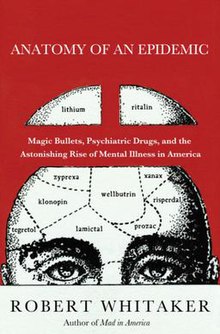
Contemporary Health issues
Item #1
Are we all going bananas?
The 1998 Pulitzer Prize Finalist and author of "Mad in America" discusses the rise in diagnosis of mental illness in the U.S. and the proliferation of drugs to medicate various conditions. Mr. Whitaker contends that drugs do little to balance imbalanced brain chemistry. The event is at the National Arts Club in New York.
Item # 2
The 1998 Pulitzer Prize Finalist and author of "Mad in America" discusses the rise in diagnosis of mental illness in the U.S. and the proliferation of drugs to medicate various conditions. Mr. Whitaker contends that drugs do little to balance imbalanced brain chemistry. The event is at the National Arts Club in New York.
- A History of Psychiatry, "Mind drugs initiated a revolution in psychiatry, comparable to the introduction of penicillin in general medicine"
Listen to WRITE_7_A. Produce a 200 word summary of Whitaker's talk the speech
- "Anatomy of an Epidemic" is an excellent book, attacked by PR operatives paid by Big Pharma ass a a kind of McCarthy-era scapegoating. Disestablishmentarians of pill-profits like Whitaker are often ruined professionally. A good book about the "Toxic Sludge is Good for You," which is about how conservative business destroys reformers. Amazon reviewer
Item # 2
About fears that women have been misled on breast cancer diagnosis.
- Are they given a truly informed choice.
- Are healthy women getting unnecessary diagnoses of conditions that are unlikely to develop during their lifetime?
Listen to WRITE_7_B. Produce a 200 word summary of Gotzsche's talk the speech
Peter Gøtzsche discusses big pharma
on this topic, read the link on Daily Mail.
FOLLOW UP
Item #1
A century ago, fewer than two people per 1,000 were considered to be "disabled" by men- tal illness and in need of hospitalisation . By 1955, that number had jumped to 3 .38 peo- ple per 1,000, and during the past 50 years, a period when psychiatric drugs have been the cornerstone of care, the disability rate has climbed steadily, and has now reached around 20 people per 1,000. (Table 2). As with any epidemic, one would suspect that an outside agent of some type-a virus, a bacterial infection, or an environmental toxin- was causing this rise in illness . That is indeed the case here . There is an outside agent fu- eling this epidemic of mental illness, only it is to be found in the medicine cabinet . Psychiatric drugs perturb normal neurotransmitter functions.
A century ago, fewer than two people per 1,000 were considered to be "disabled" by men- tal illness and in need of hospitalisation . By 1955, that number had jumped to 3 .38 peo- ple per 1,000, and during the past 50 years, a period when psychiatric drugs have been the cornerstone of care, the disability rate has climbed steadily, and has now reached around 20 people per 1,000. (Table 2). As with any epidemic, one would suspect that an outside agent of some type-a virus, a bacterial infection, or an environmental toxin- was causing this rise in illness . That is indeed the case here . There is an outside agent fu- eling this epidemic of mental illness, only it is to be found in the medicine cabinet . Psychiatric drugs perturb normal neurotransmitter functions.
Sheer data:During the past 20 years, the number of adults in the United States on federal disability rolls due to mental illness has more than tripled, rising from 1.25 million people in 1987 to more than four million in 2007. The number of children receiving a federal disability check due to severe mental illness increased 35-fold during this period, rising from 16,200 to 561,569.
The disability numbers also tell us that we need to look to develop new solutions.
- This disability data necessarily begs a question, one that our society desperately needs to investigate.
- Could our drug-based paradigm of care be fueling this epidemic of disabling illness?
- What does the scientific literature show?
- Do psychiatric medications improve or worsen long-term outcomes?
- Does their use decrease or increase the risk of long-term disability?
- And what is happening to children prescribed
- psychiatric medications over the long-term? Are they faring well?
- In India, services have begun using psychiatric medications in a selective, limited manner with low budget....
- and are now reporting very good outcomes.
- How can we adopt these methods here? ....
Item #2
Danish medical researcher, and leader of the Nordic Cochrane Center at Rigshospitalet in Copenhagen, Denmark. He has written numerous reviews within the Cochrane collaboration.- Dr.Gøtzsche has been critical of screening for breast cancer using mammography, arguing that it cannot be justified; His critique stems from a meta-analysis he did on mammography screening studies and published as Is screening for breast cancer with mammography justifiable? in The Lancet in 2000. In it he discarded 6 out of 8 studies arguing their randomization was inadequate.
- In 2006 a paper by Gøtzsche on mammography screening was electronically published in the European Journal of Cancer ahead of print. The journal later removed the paper completely from the journal website without any formal retraction. The paper was later published in Danish Medical Bulletin with a short note from the editor, and Gøtzsche and his coauthors commented on the unilateral retraction that the authors were not involved in.
In 2012 his book Mammography Screening: Truth, Lies and Controversy was published. In 2013 his book Deadly Medicines and Organized Crime: How Big Pharma has Corrupted Healthcare was published.
No comments:
Post a Comment